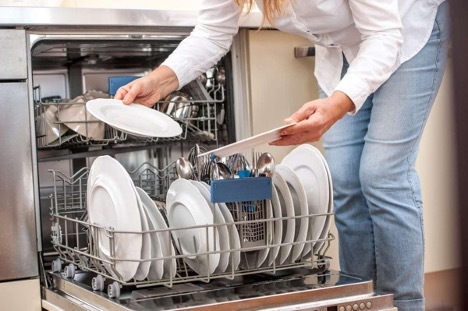The average power of the dishwasher is no more than 1 kW. This is the optimal indicator that allows you to perform all functions, including pre-rinsing and drying. However, it can deviate to a smaller and larger side. About what affects power, and how to properly evaluate it, is described in this material.
The content of the article
-
What is the difference between power and performance
- Power
- Performance
- Factors affecting power
- Energy efficiency class
- How to save electricity
What is the difference between power and performance
First of all, you need to understand the concepts, since they often get confused, not only in connection with dishwashers, but also in general with household appliances.
Power
The power of the dishwasher (kW) is the amount of energy it consumes in 1 hour. It is quite clear that the lower this indicator, the better, especially if the network already has a large load (washing machine, kettle, air conditioner and other equipment).
How much the dishwasher consumes directly affects the electricity consumption. For modern models, this figure is in the range of 0.4-2.7 kWh, and on average it is about 1-1.2 kWh. Since a standard wash lasts almost 3 hours, it is easy to calculate that for 1 cycle the unit uses 4-4.8 kW, which in rubles will be 15-25 rubles.

The power consumption of a dishwasher is consumed by several processes:
- heating water to the desired temperature (standard 40-50 degrees, but sometimes 60-70);
- the functioning of the sprinklers, as well as the pump that pumps water;
- drying process.
Performance
The consumption of a dishwasher does not always directly reflect its performance. This indicator shows how many plates or baskets will be processed in 1 hour. In the description of household devices, performance is usually not indicated, but it can be calculated indirectly. For example, the unit fits 9 sets of dishes, each of them has 4 appliances, washing lasts 3 hours. Then the productivity will be 12 conditional plates per hour.
This indicator indirectly affects how many kilowatts the dishwasher consumes. It is clear that the more productive it is, the greater the energy costs. However, for a small family, this criterion does not really matter. It is important only for units that are used in catering (there the productivity reaches 200-800 plates per hour).

Factors affecting power
The power consumption of a dishwasher depends on several factors at once:
- Features of the heating element - the heating element consumes quite a lot of energy, especially at maximum heating up to 60-70 degrees. This temperature is not needed in all cases, so you can choose programs with average values (40-50 degrees).
- A pump that generates pressure to effectively spray water. This part consumes approximately 100 watts every hour, which is quite normal. It is clear that the shorter the wash, the lower the energy consumption of the dishwasher.
- A pump that drains the waste liquid. This is an even less expensive part, it consumes only 30 watts. Moreover, thanks to water purification, it is used several times, after passing through filtration.
- The volume of water - if the consumption of the dishwasher is 1-1.2 kWh (on average), then the volume of liquid can be from 6 to 12 liters. It is clear that the smaller it is, the less energy must be expended to heat it to the desired temperature.
- The duration of the program is a determining factor that greatly affects how many kW the dishwasher consumes. A standard wash lasts 3-4 hours, while a short wash takes 40-60 minutes. During all this time, electricity is spent on the operation of pumps, heating elements and other elements.
Energy efficiency class
To make it easier for users to navigate how much electricity a dishwasher consumes, manufacturers have long used a lettering system from A to G. They characterize the energy efficiency class:
- A - the best option, power in the range of 0.7-1.05 kW. Within this group there are also A + and A ++, which corresponds to 0.6 and 0.4 kW. It is clear that such energy consumption of the dishwasher is minimal. Moreover, it retains all its functionality, that is, it uses resources extremely economically.
- B - level from 1.07 to 1.1 kW.
- C - power in the range of 1.1-1.5 kW.

The rest of the classes are practically non-existent. Even category B and C models are rarely on sale, as their energy efficiency is well below average. Infrequently, only old used units come across that consume 1.5-2 kW or more, which corresponds to the worst classes (D, E or F). The power consumption W of such a dishwasher is very large, while the functions are the same. Therefore, it is worth considering only models of class A, A + and A ++.
How to save electricity
How many watts a dishwasher consumes is always indicated in the instructions for it. Moreover, manufacturers declare an average value or stipulate a maximum flow rate, which will not necessarily go in reality. In order to reduce the power consumption of the dishwasher in kW, it is recommended to follow a few simple rules:
- Do not accumulate too many dishes, put what you have in the chamber and select the half load mode. It allows you to reduce the amount of energy consumed, as well as water by about 30%.
- When buying, find out how much the dishwasher consumes, and also whether it is equipped with a heat exchanger. With this element, you can save on electricity by about 20%.
- Periodically remove scale from the heating element, use prophylactic agents that reduce water hardness.
- Pre-clean the dishes from food residue so that they do not have to be washed. In addition, if the plates and other containers are not very dirty, you can select the economical, quick wash mode. Then you do not have to worry about how much electricity the dishwasher consumes.

If the load on the network is too strong, it is worth buying models that consume a minimum of electricity. It is necessary to study all the technical parameters, including how many kilowatts the dishwasher consumes. The indicator should not exceed 1.05 kW, otherwise the load on the network and financial costs will be quite noticeable.
Thus, the power consumption of the dishwasher plays a rather important role. But one should not think that if the indicator is large, then the cycle is going quite intensively. In fact, it is worth looking for a compromise between how much energy the dishwasher consumes and what its capacity is, as well as the performance indicator.


